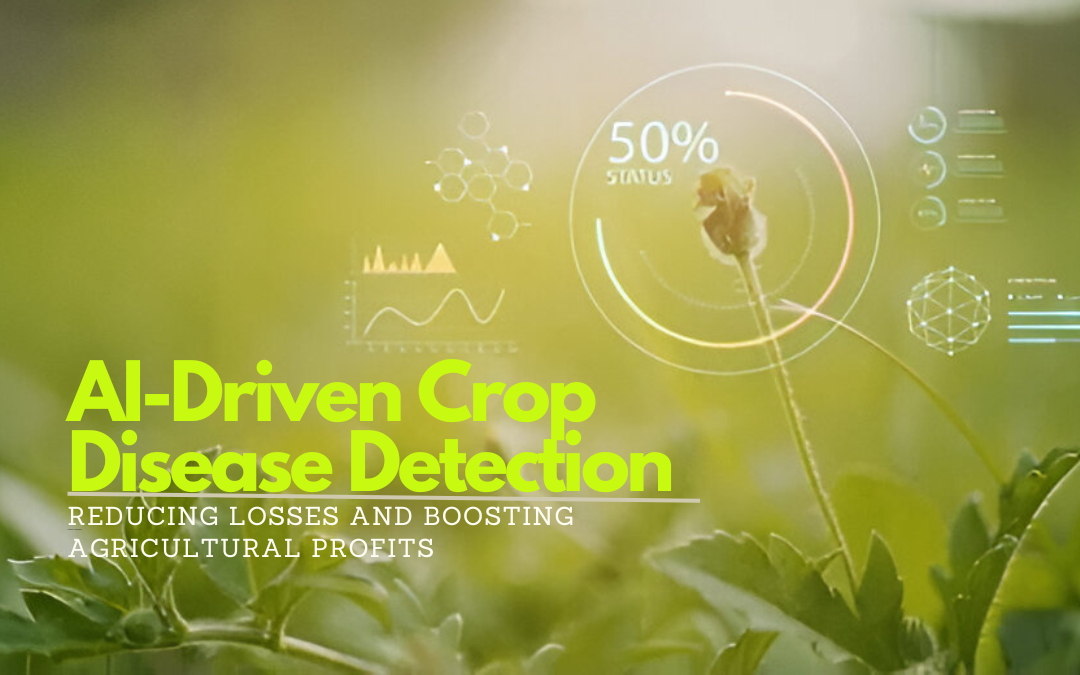The agriculture industry has long been at the mercy of crop diseases, which can cause devastating losses, reduce yield quality, and increase the cost of production. Traditionally, farmers have relied on manual inspection and chemical treatments to manage crop diseases, but these methods can be time-consuming, expensive, and not always effective. Fortunately, Artificial Intelligence (AI)-driven crop disease detection is revolutionizing how farmers tackle this age-old problem. By using advanced algorithms and data analysis, AI helps detect diseases early, reducing the need for harmful chemical treatments and boosting profitability.
How AI is Transforming Crop Disease Detection
- Early Disease Detection
AI systems use machine learning and computer vision to monitor crops in real time. Drones, sensors, and satellite imagery capture data about the crops, which AI algorithms analyze to identify early signs of disease that may not be visible to the naked eye. This enables farmers to take action before the disease spreads, reducing crop loss and protecting yield quality. - Reduction in Chemical Use
Traditional farming often involves heavy reliance on chemical pesticides and fungicides to control disease outbreaks. However, these chemicals are not only expensive but can also have negative environmental impacts. AI-driven detection systems help farmers apply targeted treatments, reducing the overall need for chemicals. This precision farming approach ensures healthier crops while lowering production costs, further enhancing profitability. - Real-Time Monitoring and Data Analysis
AI-driven systems allow for continuous monitoring of crops throughout the growing season. This real-time data provides farmers with valuable insights into the health of their fields, allowing for more informed decision-making. AI tools can predict the likelihood of disease outbreaks based on factors like weather patterns, soil conditions, and plant health, giving farmers a head start on prevention. - Cost Savings and Increased Efficiency
The use of AI in crop disease detection leads to significant cost savings. By catching diseases early, farmers can avoid widespread infestations that would require costly treatments or result in massive losses. Additionally, AI systems reduce the need for manual labor in disease monitoring, enabling farmers to allocate resources more efficiently. This increased efficiency translates into higher agricultural profits and improved sustainability.
Case Study: AI in Action
In Kenya, a startup called PlantVillage has developed an AI-powered app that uses image recognition to detect diseases in crops like maize and cassava. Farmers upload photos of their crops, and the app analyzes them to provide a diagnosis and recommend treatment options. This AI-driven solution has helped small-scale farmers save money on chemical treatments and avoid losses by identifying diseases early.
Another notable example is Microsoft’s AI for Earth program, which applies machine learning and data analytics to help farmers manage crop health. In India, the program is being used to detect cotton crop diseases, providing real-time insights to farmers and allowing them to address issues before they escalate. The result has been a significant reduction in chemical use and increased yields for farmers participating in the initiative.
AI-Driven Disease Detection Boosts Business Profitability
By implementing AI-driven crop disease detection, farmers can achieve a variety of benefits that directly impact their bottom line:
- Higher Yields: Early detection ensures that more crops make it to harvest, increasing overall production.
- Reduced Costs: Precision treatments cut down on the need for expensive chemicals and reduce manual labor requirements.
- Improved Crop Quality: By preventing the spread of disease, farmers can produce healthier, higher-quality crops, which often fetch premium prices in the market.
- Sustainable Farming Practices: Reduced chemical use leads to more sustainable farming practices, appealing to eco-conscious consumers and positioning farmers for long-term success.
AI Tools for Crop Disease Detection and Their Impact on Agriculture
Some of the most effective AI tools used in crop disease detection and how they contribute to reducing losses and boosting agricultural profits.
1. PlantVillage Nuru
- What It Is: PlantVillage Nuru is an AI-powered mobile app designed for small-scale farmers. It uses machine learning and image recognition technology to detect crop diseases.
- How It Helps: Farmers simply take pictures of their crops, and Nuru analyzes the images to detect signs of disease. It provides immediate feedback on the diagnosis and offers actionable recommendations, such as disease management practices. This tool helps farmers detect diseases early, reducing the need for large-scale chemical interventions and preventing significant crop losses.
2. Taranis
- What It Is: Taranis is an AI-based precision agriculture platform that combines satellite imagery, drones, and data analytics to monitor large-scale farms.
- How It Helps: The platform captures high-resolution images of fields and uses AI to detect diseases, pests, and nutrient deficiencies in crops. Farmers can identify problem areas in real-time and take quick action to prevent disease spread. This level of precision allows farmers to target specific areas for treatment, saving costs on chemicals and improving crop health across the board.
3. Microsoft Azure FarmBeats
- What It Is: Azure FarmBeats is a cloud-based platform that integrates AI, IoT (Internet of Things), and big data analytics to help farmers monitor their crops and predict disease outbreaks.
- How It Helps: Through sensors placed in the fields, drones, and satellite data, FarmBeats collects a wealth of information on soil moisture, weather patterns, and crop health. AI models analyze this data to predict potential disease outbreaks, enabling farmers to implement preventive measures well in advance. This reduces reliance on chemicals and ensures healthier crop yields.
4. John Deere’s See & Spray
- What It Is: John Deere’s See & Spray is an AI-powered agricultural tool designed for precision spraying. It utilizes machine learning and computer vision to differentiate between crops and weeds.
- How It Helps: By identifying only the areas that need treatment, See & Spray applies herbicides or pesticides with pinpoint accuracy, significantly reducing chemical usage. This AI tool not only helps manage weeds but also detects early signs of disease, ensuring that crops are treated at the right time and in the right way.
5. SkySquirrel Technologies
- What It Is: SkySquirrel Technologies provides AI-driven solutions for vineyard management. It uses drone technology combined with machine learning algorithms to monitor the health of grapevines.
- How It Helps: The drones capture aerial images of vineyards, which are then analyzed by AI algorithms to detect disease symptoms. Farmers receive detailed reports on the health status of their vines, enabling early interventions and reducing the need for chemical treatments. The tool has proven highly effective in improving grape quality and reducing loss due to diseases like downy mildew.
6. Prospera
- What It Is: Prospera is an AI-powered crop monitoring system that uses computer vision and data analytics to detect diseases and monitor crop health in real time.
- How It Helps: Prospera collects data from sensors, cameras, and other agricultural equipment, and AI algorithms analyze this data to identify abnormalities in crop health. Farmers are alerted when diseases are detected, allowing for timely interventions that minimize crop loss and reduce input costs such as fertilizers and pesticides.
Future of AI in Agriculture
As AI technology continues to evolve, its applications in agriculture will expand, offering even more sophisticated disease detection and prevention tools. Emerging trends such as AI-powered robots for field monitoring and predictive analytics to forecast disease outbreaks are poised to further reduce crop losses and maximize agricultural profits.
Conclusion
AI-driven crop disease detection is transforming the agricultural industry, offering farmers a powerful tool to reduce losses, decrease the use of harmful chemicals, and increase profitability. By leveraging AI technology, farmers can ensure healthier crops, more sustainable practices, and higher yields, positioning themselves for success in a rapidly evolving agricultural landscape.
Embracing AI in agriculture is no longer a luxury but a necessity for any farmer looking to stay competitive and boost their bottom line.












